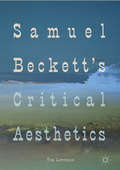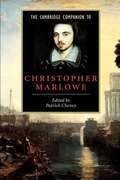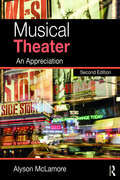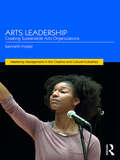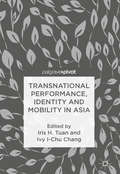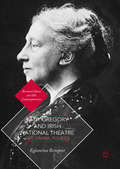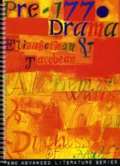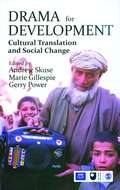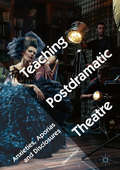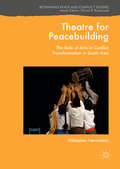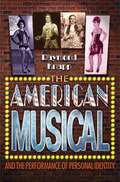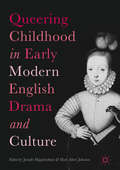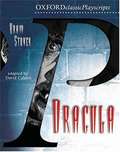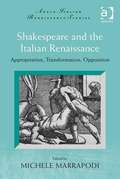- Table View
- List View
Samuel Beckett's Critical Aesthetics
by Tim LawrenceThis book considers how Samuel Beckett’s critical essays, dialogues and reflections drew together longstanding philosophical discourses about the nature of representation, and fostered crucial, yet overlooked, connections between these discourses and his fiction and poetry. It also pays attention to Beckett’s writing for little-magazines in France from the 1930s to the 1950s, before going on to consider how the style of Beckett’s late prose recalls and develops figures and themes in his critical writing. By providing a long-overdue assessment of Beckett’s work as a critic, this study shows how Beckett developed a new aesthetic in knowing dialogue with ideas including phenomenology, Kandinsky’s theories of abstraction, and avant-garde movements such as Surrealism. This book will be illuminating for students and researchers interested not just in Beckett, but in literary modernism, the avant-garde, European visual culture and philosophy.
Hand to God
by Robert AskinsPuppets are creepy. People are weird. Death is hard. A mother and son are grieving. A Pastor is trying to help. A bully’s in love. And a smart young women is trying to help them all do a puppet show… For Jesus. Everybody’s just barely keeping it together. Then the puppets start to talk on their own. Uh-oh. The devil has the answers. Somebody’s gonna bleed. Nothing will ever be the same. Welcome to Texas.
Dante: The Divine Comedy, 2nd Edition (PDF)
by Robin KirkpatrickIn this accessible critical introduction to Dante's Divine Comedy Robin Kirkpatrick principally focuses on Dante as a poet and storyteller. He addresses important questions such as Dante's attitude towards Virgil, and demonstrates how an early work such as the Vita nuova is a principal source of the literary achievement of the Comedy. His detailed reading reveals how the great narrative poem explores the relationship that Dante believed to exist between God as creator of the universe and the human being as a creature of God. In addition, Kirkpatrick takes due account of the historical and philosophical dimensions of the poem.
The Cambridge Companion to Christopher Marlowe (PDF)
by Edited by Patrick CheneyThe Cambridge Companion to Christopher Marlowe, first published in 2004, provides a full introduction to one of the great pioneers of both the Elizabethan stage and modern English poetry. It recalls that Marlowe was an inventor of the English history play (Edward II) and of Ovidian narrative verse (Hero and Leander), as well as being author of such masterpieces of tragedy and lyric as Doctor Faustus and 'The Passionate Shepherd to his Love'. Sixteen leading scholars provide accessible and authoritative chapters on Marlowe's life, texts, style, politics, religion, and classicism. The volume also considers his literary and patronage relationships and his representations of sexuality and gender and of geography and identity; his presence in modern film and theatre; and finally his influence on subsequent writers.
The Cambridge Introduction to Shakespeare's History Plays (PDF)
by Warren ChernaikShakespeare's history plays, as fresh today as when they were written, are based upon the assumption that time is not simply a destroyer but a preserver, and that 'examples past' might enable us to understand the present and anticipate the future. This lively 2007 study examines the continuing tradition of Shakespeare's history plays in stage and film productions as well as giving an account of the critical debate on these plays. Following two introductory chapters giving essential background on the genre, the English history plays are discussed in turn, bringing out the distinctive characteristics of each play: the three early Henry VI plays; the perennial stage favourite Richard III; King John; Richard II; Henry IV 1 and 2, famous for the character of Falstaff; Henry V, which is treated very differently in the film versions by Olivier and Branagh; and Henry VIII. An invaluable introduction to these fascinating and complex plays.
Christopher Marlowe in Context (PDF)
by Edited by Emily C. Bartels Emma SmithA contemporary of William Shakespeare and Ben Jonson, Christopher Marlowe was one of the most influential early modern dramatists, whose life and mysterious death have long been the subject of critical and popular speculation. This collection sets Marlowe's plays and poems in their historical context, exploring his world and his wider cultural influence. Chapters by leading international scholars discuss both his major and lesser-known works. Divided into three sections, 'Marlowe's works', 'Marlowe's world', and 'Marlowe's reception', the book ranges from Marlowe's relationship with his own audience through to adaptations of his plays for modern cinema. Other contexts for Marlowe include history and politics, religion and science. Discussions of Marlowe's critics and Marlowe's appeal today, in performance, literature and biography, show how and why his works continue to resonate; and a comprehensive further reading list provides helpful suggestions for those who want to find out more.
Shakespeare Survey, Volume 46: Shakespeare and Sexuality (PDF)
by Edited by Stanley WellsShakespeare Survey is a yearbook of Shakespeare studies and production. Since 1948 Survey has published the best international scholarship in English and many of its essays have become classics of Shakespeare criticism. Each volume is devoted to a theme, or play, or group of plays; each also contains a section of reviews of the previous year's textual and critical studies and of major British performances. The books are illustrated with a variety of Shakespearean images and production photographs. The current editor of Survey is Peter Holland. The first eighteen volumes were edited by Allardyce Nicoll, numbers 19-33 by Kenneth Muir and numbers 34-52 by Stanley Wells. The virtues of accessible scholarship and a keen interest in performance, from Shakespeare's time to our own, have characterised the journal from the start. For the first time, numbers 1-50 are being reissued in paperback, available separately and as a set.
Musical Theater: An Appreciation
by Alyson McLamoreMusical Theater: An Appreciation, Second Edition offers a history of musical theater from its operating origins to the Broadway shows of today, combined with an in-depth study of the musical styles that paralleled changes on stage. Alyson McLamore teaches readers how to listen to both the words and the music of the stage musical, enabling them to understand how all the components of a show interact to create a compelling experience for audiences. This second edition has been updated with new chapters covering recent developments in the twenty-first century, while insights from recent scholarship on musical theater have been incorporated throughout the text. The musical examples discussed in the text now include detailed listening guides, while a new companion website includes plot summaries and links to audio of the musical examples. From Don Giovanni to Hamilton, Musical Theater: An Appreciation both explores the history of musical theater and develops a deep appreciation of the musical elements at the heart of this unique art form.
Arts Leadership: Creating Sustainable Arts Organizations (Mastering Management in the Creative and Cultural Industries)
by Kenneth FosterThe contemporary world faces unprecedented upheaval and change forcing institutions of all types to rethink how they are designed and how they must now function if they are to survive into an uncertain future. The performing arts are no exception; in an era of constant change and technological transformation, arts organizations and their leaders face significant organizational challenges if they are to maintain their relevance. Arts Leadership: Creating Sustainable Arts Organizations provides a contemporary overview of the field of arts leadership, focused on the performing arts. It examines what these challenges are, how they are affecting the performing arts and arts organizations in general and proposes creative ways to reimagine, build and lead sustainable arts organizations in this uncharted environment. With a global perspective drawn from his extensive experience advising arts organizations around the world and based on his own work successfully leading important performing arts organizations in the United States, Foster proposes an innovative approach to organizational design, systems, and structures for arts leaders in the 21st century that is based in ecological thinking and the creative process that is intrinsic to the arts. In disrupting conventional arts leadership practice, the book provides an exceptional tool to understand a unique sector, and is essential reading for students and practitioners across the creative and cultural industries.
Arts Leadership: Creating Sustainable Arts Organizations (Mastering Management in the Creative and Cultural Industries)
by Kenneth FosterThe contemporary world faces unprecedented upheaval and change forcing institutions of all types to rethink how they are designed and how they must now function if they are to survive into an uncertain future. The performing arts are no exception; in an era of constant change and technological transformation, arts organizations and their leaders face significant organizational challenges if they are to maintain their relevance. Arts Leadership: Creating Sustainable Arts Organizations provides a contemporary overview of the field of arts leadership, focused on the performing arts. It examines what these challenges are, how they are affecting the performing arts and arts organizations in general and proposes creative ways to reimagine, build and lead sustainable arts organizations in this uncharted environment. With a global perspective drawn from his extensive experience advising arts organizations around the world and based on his own work successfully leading important performing arts organizations in the United States, Foster proposes an innovative approach to organizational design, systems, and structures for arts leaders in the 21st century that is based in ecological thinking and the creative process that is intrinsic to the arts. In disrupting conventional arts leadership practice, the book provides an exceptional tool to understand a unique sector, and is essential reading for students and practitioners across the creative and cultural industries.
Transnational Performance, Identity and Mobility in Asia
by Iris H. Tuan Ivy I-Chu ChangThis pivot considers the history, methodology and practice of Asian theatre and investigates the role of Asian theatre and film in contemporary transnational Asian identities. It critically reviews the topics of transnationalism and intercultural political difference, arguing that the concept of Transnational Asian theatre or 'TransAsia' acan promote cultural diversity and social transformation. The book notably offers an understanding of theatre as a cultural laboratory, a repository for diverse histories and a forum for intercultural dialogue, allowing for a better understanding of sociocultural patterns surrounding transnational Asian identity and mobility.
Transnational Performance, Identity and Mobility in Asia
by Iris H. Tuan Ivy I-Chu ChangThis pivot considers the history, methodology and practice of Asian theatre and investigates the role of Asian theatre and film in contemporary transnational Asian identities. It critically reviews the topics of transnationalism and intercultural political difference, arguing that the concept of Transnational Asian theatre or 'TransAsia' acan promote cultural diversity and social transformation. The book notably offers an understanding of theatre as a cultural laboratory, a repository for diverse histories and a forum for intercultural dialogue, allowing for a better understanding of sociocultural patterns surrounding transnational Asian identity and mobility.
Lady Gregory and Irish National Theatre: Art, Drama, Politics (Bernard Shaw And His Contemporaries Ser.)
by Eglantina RemportThis book is the first comprehensive critical assessment of the aesthetic and social ideals of Lady Augusta Gregory, founder, patron, director, and dramatist of the Abbey Theatre in Dublin. It elaborates on her distinctive vision of the social role of a National Theatre in Ireland, especially in relation to the various reform movements of her age: the Pre-Raphaelite Movement, the Co-operative Movement, and the Home Industries Movement. It illustrates the impact of John Ruskin on the aesthetic and social ideals of Lady Gregory and her circle that included Horace Plunkett, George Russell, John Millington Synge, William Butler Yeats, and George Bernard Shaw. All of these friends visited the celebrated Gregory residence of Coole Park in Country Galway, most famously Yeats. The study thus provides a pioneering evaluation of Ruskin’s immense influence on artistic, social, and political discourse in Ireland in the late nineteenth and early twentieth century.
Pre-1770 Drama: Elizabethan and Jacobean (EMC Advanced Literature Series) (PDF)
by David Kinder Juliet Harrison128-page photocopiable pack introduces the cultural, social, historical and literary contexts of the period through the study of substantial extracts from a range of set texts.
Drama For Development (PDF): Cultural Translation And Social Change
by Marie Gillespie Andrew Skuse Gerry PowerTeaching Postdramatic Theatre: Anxieties, Aporias and Disclosures
by Glenn D'CruzThis book explores the concept and vocabulary of postdramatic theatre from a pedagogical perspective. It identifies some of the major anxieties and paradoxes generated by teaching postdramatic theatre through practice, with reference to the aesthetic, cultural and institutional pressures that shape teaching practices. It also presents a series of case studies that identify the pedagogical fault lines that expose the power-relations inherent in teaching (with a focus on the higher education sector as opposed to actor training institutions). It uses auto-ethnography, performance analysis and critical theory to assist university teachers involved in directing theatre productions to deepen their understanding of the concept of postdramatic theatre.
Teaching Postdramatic Theatre: Anxieties, Aporias and Disclosures
by Glenn D'CruzThis book explores the concept and vocabulary of postdramatic theatre from a pedagogical perspective. It identifies some of the major anxieties and paradoxes generated by teaching postdramatic theatre through practice, with reference to the aesthetic, cultural and institutional pressures that shape teaching practices. It also presents a series of case studies that identify the pedagogical fault lines that expose the power-relations inherent in teaching (with a focus on the higher education sector as opposed to actor training institutions). It uses auto-ethnography, performance analysis and critical theory to assist university teachers involved in directing theatre productions to deepen their understanding of the concept of postdramatic theatre.
Theatre for Peacebuilding: The Role of Arts in Conflict Transformation in South Asia (Rethinking Peace and Conflict Studies)
by Nilanjana PremaratnaThis book contributes to key debates in peacebuilding by exploring the role of theatre and art in general. Premaratna argues that the dialogical and multi-voiced nature of theatre is particularly suited to assisting societies coming to terms with conflict and opening up possibilities for conversation. These are important parts of the peacebuilding process. The book engages the conceptual links between theatre and peacebuilding and then offers an in-depth empirical exploration of how three South Asian theatre groups approach peacebuilding: Jana Karaliya in Sri Lanka, Jana Sanskriti in India, and Sarwanam in Nepal. The ensuing reflections offer insights that are relevant to both students and practitioners concerned with issues of peace and conflict.
Theatre for Peacebuilding: The Role of Arts in Conflict Transformation in South Asia (Rethinking Peace and Conflict Studies)
by Nilanjana PremaratnaThis book contributes to key debates in peacebuilding by exploring the role of theatre and art in general. Premaratna argues that the dialogical and multi-voiced nature of theatre is particularly suited to assisting societies coming to terms with conflict and opening up possibilities for conversation. These are important parts of the peacebuilding process. The book engages the conceptual links between theatre and peacebuilding and then offers an in-depth empirical exploration of how three South Asian theatre groups approach peacebuilding: Jana Karaliya in Sri Lanka, Jana Sanskriti in India, and Sarwanam in Nepal. The ensuing reflections offer insights that are relevant to both students and practitioners concerned with issues of peace and conflict.
The American Musical and the Performance of Personal Identity
by Raymond KnappThe American musical has long provided an important vehicle through which writers, performers, and audiences reimagine who they are and how they might best interact with the world around them. Musicals are especially good at this because they provide not only an opportunity for us to enact dramatic versions of alternative identities, but also the material for performing such alternatives in the real world, through songs and the characters and attitudes those songs project. This book addresses a variety of specific themes in musicals that serve this general function: fairy tale and fantasy, idealism and inspiration, gender and sexuality, and relationships, among others. It also considers three overlapping genres that are central, in quite different ways, to the projection of personal identity: operetta, movie musicals, and operatic musicals. Among the musicals discussed are Camelot, Candide; Chicago; Company; Evita; Gypsy; Into the Woods; Kiss Me, Kate; A Little Night Music; Man of La Mancha; Meet Me in St. Louis; The Merry Widow; Moulin Rouge; My Fair Lady; Passion; The Rocky Horror Picture Show; Singin' in the Rain; Stormy Weather; Sweeney Todd; and The Wizard of Oz. Complementing the author's earlier work, The American Musical and the Formation of National Identity, this book completes a two-volume thematic history of the genre, designed for general audiences and specialists alike.
The American Musical and the Performance of Personal Identity
by Raymond KnappThe American musical has long provided an important vehicle through which writers, performers, and audiences reimagine who they are and how they might best interact with the world around them. Musicals are especially good at this because they provide not only an opportunity for us to enact dramatic versions of alternative identities, but also the material for performing such alternatives in the real world, through songs and the characters and attitudes those songs project. This book addresses a variety of specific themes in musicals that serve this general function: fairy tale and fantasy, idealism and inspiration, gender and sexuality, and relationships, among others. It also considers three overlapping genres that are central, in quite different ways, to the projection of personal identity: operetta, movie musicals, and operatic musicals. Among the musicals discussed are Camelot, Candide; Chicago; Company; Evita; Gypsy; Into the Woods; Kiss Me, Kate; A Little Night Music; Man of La Mancha; Meet Me in St. Louis; The Merry Widow; Moulin Rouge; My Fair Lady; Passion; The Rocky Horror Picture Show; Singin' in the Rain; Stormy Weather; Sweeney Todd; and The Wizard of Oz. Complementing the author's earlier work, The American Musical and the Formation of National Identity, this book completes a two-volume thematic history of the genre, designed for general audiences and specialists alike.
Queering Childhood in Early Modern English Drama and Culture
by Jennifer Higginbotham Mark Albert JohnstonThis volume analyzes early modern cultural representations of children and childhood through the literature and drama of Shakespeare and his contemporaries. Contributors include leading international scholars of the English Renaissance whose essays consider asexuals and sodomites, roaring girls and schoolboys, precocious princes and raucous tomboys, boy actors and female apprentices, while discussing a broad array of topics, from animal studies to performance theory, from queer time to queer fat, from teaching strategies to casting choices, and from metamorphic sex changes to rape and cannibalism. The collection interrogates the cultural and historical contingencies of childhood in an effort to expose, theorize, historicize, and explicate the spectacular queerness of early modern dramatic depictions of children.
Queering Childhood in Early Modern English Drama and Culture
by Jennifer Higginbotham Mark Albert JohnstonThis volume analyzes early modern cultural representations of children and childhood through the literature and drama of Shakespeare and his contemporaries. Contributors include leading international scholars of the English Renaissance whose essays consider asexuals and sodomites, roaring girls and schoolboys, precocious princes and raucous tomboys, boy actors and female apprentices, while discussing a broad array of topics, from animal studies to performance theory, from queer time to queer fat, from teaching strategies to casting choices, and from metamorphic sex changes to rape and cannibalism. The collection interrogates the cultural and historical contingencies of childhood in an effort to expose, theorize, historicize, and explicate the spectacular queerness of early modern dramatic depictions of children.
Oxford Playscripts: Dracula (PDF)
by Bram Stoker David CalcuttOxford Classic Playscripts: DraculaHe is Nosferatu, the Undead. He can walk through locked doors, change his shape. Sometimes he looks like a man, sometimes a huge wolf-like dog, or a bat. He never grows ill, never diesAnd if you invite him into your home, he will take your life and your soul. * New, innovative activities specifically tailored to support the KS3 Framework for Teaching English and help students to fulfil the Framework objectives. Activities include work on Speaking and Listening, close text analysis, and the structure of playscripts, and act as a springboard for personalwriting
Shakespeare And The Italian Renaissance: Appropriation, Transformation, Opposition (PDF)
by Michele MarrapodiShakespeare and the Italian Renaissance investigates the works of Shakespeare and his fellow dramatists from within the context of the European Renaissance and, more specifically, from within the context of Italian cultural, dramatic, and literary traditions, with reference to the impact and influence of classical, coeval, and contemporary culture. In contrast to previous studies, the critical perspectives pursued in this volume’s tripartite organization take into account a wider European intertextual dimension and, above all, an ideological interpretation of the 'aesthetics' or 'politics' of intertextuality. Contributors perceive the presence of the Italian world in early modern England not as a traditional treasure trove of influence and imitation, but as a potential cultural force, consonant with complex processes of appropriation, transformation, and ideological opposition through a continuous dialectical interchange of compliance and subversion.
